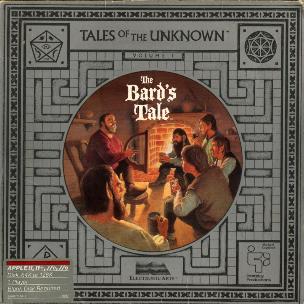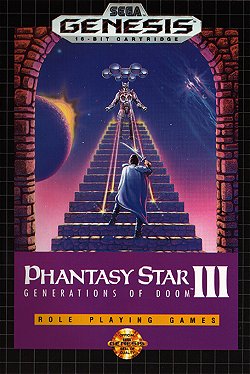Related Research Articles

The Bard's Tale is a fantasy role-playing video game designed and programmed by Michael Cranford for the Apple II. It was produced by Interplay Productions in 1985 and distributed by Electronic Arts. The game was ported to the Commodore 64, Apple IIGS, ZX Spectrum, Amstrad CPC, Amiga, Atari ST, DOS, Macintosh, and NES. It spawned The Bard's Tale series of games and books. The earliest editions of the game used a series title of Tales of the Unknown, but this title was dropped for later ports of The Bard's Tale and subsequent games in the series.
Tactical role-playing games, also known as strategy role-playing games and in Japan as simulation RPGs, are a video game genre that combines core elements of role-playing video games with those of tactical strategy video games. The formats of tactical RPGs are much like traditional tabletop role-playing games and strategy games in appearance, pacing, and rule structure. Likewise, early tabletop role-playing games are descended from skirmish wargames such as Chainmail, which were primarily concerned with combat.

The Bard's Tale II: The Destiny Knight is a fantasy role-playing video game created by Interplay Productions in 1986. It is the first sequel to The Bard's Tale, and the last game of the series that was designed and programmed by Michael Cranford.

Phantasy Star III: Generations of Doom is a role-playing video game developed and published by Sega. It was released for the Sega Genesis in Japan in April 1990 and worldwide the following year. It is the third game in the original Phantasy Star series, and is a distant sequel to the previous games. However, gameplay is similar to the previous games, with turn-based combat and random encounters. Players explore various overworld maps and dungeons in order to progress through the game. It was later re-released on the Virtual Console and on retro collections such as the Phantasy Star Collection, Sega Genesis Collection, and Sonic's Ultimate Genesis Collection.

Suikoden II is a role-playing video game developed and published by Konami for the PlayStation video game console and the second installment of the Suikoden video game series. It was released in late 1998 in Japan, 1999 in North America, and in 2000 in Europe. The game features a vast array of characters, with over 100 recruitable characters, of which over 40 are usable in combat.

Fullmetal Alchemist and the Broken Angel is an action role-playing game developed by Racjin and published by Square Enix for the PlayStation 2 console. The game features an original story by Hiromu Arakawa from the creator of the Fullmetal Alchemist manga. It is based on the Fullmetal Alchemist manga series, also published by Square Enix. The game was released in Japan on December 25, 2003, and in North America on January 18, 2005.

Alpha Kimori is a trilogy of episodic sprite-based role-playing video games. Its art style is anime-inspired. It markets itself as having a highly philosophical plot combined with a traditional Japanese RPG turn-based battle system. Alpha Kimori is independently developed by Sherman Chin and Sherman3D. It was produced using the RPG Maker engine.

Shining Force III is a tactical role-playing game released for the Sega Saturn. In Japan, Shining Force III refers to a collective three separate game releases - Scenario 1, Scenario 2, and Scenario 3, released across late 1997 and 1998. Each scenario follows a different perspective of a character in an overarching narrative across a shared game world and gameplay mechanics. In North America and Europe, only the first entry, Scenario 1, was translated into English, and was simply titled Shining Force 3 for its release in mid-1998.

Suikoden is a role-playing video game published by Konami. It is the first installment of the Suikoden series. Developed by Konami Computer Entertainment Tokyo, it was released initially in 1995 for the PlayStation in Japan. A North American release followed one year later, and a mainland European release came the following April. The game was also released for Windows and Sega Saturn in 1998, but only in Japan.

Aveyond is a role-playing video game series by Aveyond Studios. It is set in a fantasy medieval world in which players attempt to save the world from evil beings, with a number of side quests available. There are eight games thus far in the series: the first two full games, the four "chapter" releases of the third game, the full fourth game, and the free prequel, Ahriman's Prophecy. All the games in the series were made with RPG Maker XP; Amaranth Games was the first developer to popularize RPG Maker as a commercial tool in 2006. Several of the games were subsequently released for Linux and Mac, along with Windows.

Star Wolves is a real-time, futuristic video game developed by Russian video game developer X-bow Software combining role-playing and real-time tactics gameplay. It was first published in 2004 in Russia by 1C Company, and later in 2005 and 2006 in other parts of Europe and North America, respectively. A sequel, Star Wolves 2, was published in Russia in 2006 and in North America in 2007. Star Wolves 2: Civil War is the latest game in the series.

Eternal Eden is a 2D Japanese-style RPG created for the PC by Blossomsoft. The game was created using RPG Maker VX.

Cladun: This is an RPG, known in Japan as Classic Dungeon: Fuyoku no Masōjin, is a 2010 action role-playing video game developed by System Prisma and published by Nippon Ichi Software for the PlayStation Portable. The game was released in Japan on February 18, 2010, in North America on September 20, 2010 and in Europe on November 17, 2010.
Operation Rainfall, commonly known as oprainfall, was a video game-oriented fan campaign founded to promote the release of games not available in North America. Initially aimed at promoting the North American release of three games on the aging Wii home video game console only released in Japan and Europe, it later transitioned into a community blog dedicated to niche Japanese games and further fan campaigns aimed at the localization of Japan-exclusive games. From inception, its stated intention was to show publisher Nintendo the demand for the three chosen games.
Millennium is a Japanese-style role-playing video game series by Aldorlea Games. It is set in a fantasy medieval world where players take control of a young peasant girl named Marine. Several other characters join her later in the game and in the sequels. There are five games in the series. All the games in the series were made with RPG Maker XP and are designed so they can either be played as stand-alone or importing savefiles from one game to another.
The Star Wars Roleplaying Game is a tabletop role-playing game set in the Star Wars universe, first published by Fantasy Flight Games in 2012. It consists of different standalone cross-compatible games where each one is a separate themed experience. The sourcebooks support games set from the Clone Wars era to the original Star Wars trilogy era; there is limited support for the Star Wars sequel trilogy era. Since 2020, the game line has been maintained by Asmodee's subsidiary Edge Studio.

Infinity is a series of visual novel video games mainly developed by KID. The first game in the series, Never 7: The End of Infinity, was originally released as Infinity for PlayStation in 2000, and was later ported to other platforms. Since then, four more games have been developed, as well as a remake of the second game. The first three games were directed by Takumi Nakazawa, and the first four were planned and written by Kotaro Uchikoshi and composed for by Takeshi Abo. The fifth was written by the otome writing group Run & Gun, and featured sound production by the band Milktub. Alongside Memories Off, Infinity was KID's flagship series.

Fuga: Melodies of Steel is a tactical role-playing video game developed and published by CyberConnect2. It is the fourth title in the company's Little Tail Bronx series and it serves as a prequel to Tail Concerto and Solatorobo: Red the Hunter. The game takes place in a war-torn world populated by anthropomorphic dogs and cats, where a group of children struggle for survival aboard a giant tank against soldiers from an enemy nation. It was released in July 2021 for Microsoft Windows, Nintendo Switch, PlayStation 4, PlayStation 5, Xbox One, and Xbox Series X/S.

The New Republic: Dark Force Rising Sourcebook is a supplement published by West End Games in 1992 for the science fiction role-playing Star Wars: The Roleplaying Game.
References
- ↑ "Amaranth Game List". Amaranth. Retrieved 2011-07-10.
- ↑ "Laxius Force on Big Fish Games". Big Fish Games. Retrieved 2011-07-10.
- ↑ "3 Stars of Destiny on Big Fish Games". Big Fish Games. Retrieved 2011-07-10.
- ↑ "Laxius Force on Impulse Driven". GameStop. Retrieved 2011-07-10.
- ↑ "Laxius Force on Gamestop". GameStop. Retrieved 2011-07-02.
- ↑ "3 Stars of Destiny on Impulse Driven". GameStop. Retrieved 2011-07-10.
- ↑ "Laxius Force on Gamersgate". Gamersgate. Retrieved 2011-07-02.
- ↑ "Laxius Force on Amazon". Amazon. Retrieved 2011-07-10.
- ↑ "3 Stars of Destiny on Amazon". Amazon. Retrieved 2011-07-10.
- ↑ "Laxius Power on HOTU". HOTU. Retrieved 2011-07-10.
- ↑ John B (2009-01-31). "Laxius Force Review". Jayisgames. Retrieved 2011-07-02.
- ↑ "Laxius Force". Aldorlea. Retrieved 2011-07-10.
- ↑ David Dr. Gonzo Griffiths. "Laxius Force Review". GDN. Retrieved 2011-07-10.
- ↑ Marsh, Steve (2008-09-24). "Laxius Force Review". Cosmogaming. Retrieved 2011-07-10.
- ↑ John B (2009-01-31). "Laxius Force Review". Jayisgames. Retrieved 2011-07-10.
- ↑ Schommer, Jennifer (2008-11-03). "Laxius Force Review". Casual Gamer Chick. Retrieved 2011-07-10.
- ↑ Chandran, Neal. "Laxius Force Review". RPG Fan. Retrieved 2011-07-10.
- ↑ Stock, Robert. "Laxius Force Review". Just-RPG. Retrieved 2011-07-10.
- ↑ "IGF". IGF. Retrieved 2011-07-04.
- ↑ Chandran, Neal. "Laxius Force 2 Review". RPG Fan. Retrieved 2011-07-10.
- ↑ Stock, Robert. "Laxius Force 2 Review". Just-RPG. Retrieved 2011-07-10.
- ↑ Chandran, Neal. "Laxius Force 3 Review". RPG Fan. Retrieved 2011-07-10.
- ↑ Sapieha, Chad (2009-04-27). "3 Stars of Destiny Review". Gamezebo. Retrieved 2011-06-05.
- ↑ Filonov, Aleksei. "3 Stars of Destiny Review". GDN. Retrieved 2011-07-02.
- ↑ Chandran, Neal. "3 Stars of Destiny Review". RPG Fan. Retrieved 2011-07-02.